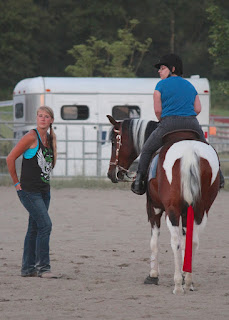To rein a horse is " to willingly guide with no resistance"
Anyone that knows me, knows that outside of my job, another big passion for me is the equestrian sport of Reining. According to the National Reining Horse Association (NRHA), the sport of reining is designed to show the athletic ability of a ranch type horse within the confines of a show arena.","
In reining, riders perform a series of manoeuvres including small slow circles, large fast circles, 360degree spins done in place, roll backs over the hocks and the exciting sliding stops. All of these manoeuvres are performed on a loose rein, and the horse must not show any resistance. To the untrained eye, it is very difficult to see the subtle cues that the rider communicates to the horse that dictates the movements of the horse. If you have never seen a reining competition, here is one example. One of my favorite reining horses ever!
Reining came into the mainstream spotlight in 2006 when reining trainer, Stacy Westfall performed a bridleless/saddleless freestyle (set to music) reining pattern in competition and it caught the eye of Ellen DeGeneres.
The relationship between horses and humans is unique. Horse are animals of prey and in the wild, survive on flight instinct. In other words, in situations where they feel threatened, or concerned, they will run away. They also rely on being part of a group (safety in numbers), being very aware of their surroundings, and being suspicious of any intrusions into the herd. They are very in tune to reading body language, as this is how they communicate their own intents.
My little reining mare Jewel is a horse that despite her extensive training is very suspicious and cautious by nature. Every time you interact with her you have to reestablish trust. This can happen pretty quickly if you know what you are doing, but if not, you would think she had never been handled by a human before. Once she has your trust, however, she will depend on you in stressful situations. For example, she was used in a Para Reining event a few years back, which paired riders of varied levels of abilities with reining horses, and were coached over 2 days, culminating in a competition.
 |
| My daughter, Casandra Jakubiec, acting as coach for para reiner rider, Tara Kowalski |
Humans, on the other hand, are predators, by nature, and therefore hold a natural threat to horses, simply by our status as a predator. However, horses are quick to follow a leader in the herd, and look for a leader that is confident, decisive and trustworthy. The leader in the herd leads by showing the way! Good horse trainers know this, and study horse behavior to capitalize on the horse's instinct to follow a good leader. For me, the sport of reining is a pinnacle showcase of the positive relationship between the leader(rider) and (follower) horse.
Anyone who has tried to force a horse to do something it doesn't want to do, understands quickly the phrase, about leading a horse to water. A horse is a 1500 lb animal capable of running 40 mph. We cannot physically force a horse to do something it does not want to do. How then can Stacy Westphal have her horse perform highly technical skills without a bridle or saddle, in an unfamiliar environment, with lots of distractions, and no other means of control besides her voice and her body?
Perhaps it is best explained by Nancy Lowery owner and operator of The Natural Leader, where she works with corporate groups to build leadership skills through working with horses. Nancy's program teaches participants that leadership:
• is personal power not physical
• title means nothing; it is about the relationships you develop
• is earned through demonstrating authenticity & gaining trust.
In her TED Talk, Nancy discusses the importance of "being present in relationship with others", by "finding the rhythm of another individual". She uses a dressage( often compared as the English equivalent of reining) term, SCHYUNG to describe this dynamic.
Nancy's program focuses on the work of Kouzes and Posner, who developed the "Five Practices of Exemplary Leadership" :
 |
| Five Practices of Exemplary Leadership & Ten Commitments (Pace OD Consulting 2015) |
1) Visionary
2) Empathetic
3) Models Learning
4) Open Risk Taker
5) Networked
6) Observant
7) Team Builder
8) ALWAYS FOCUSED ON RELATIONSHIPS
 |
| What does it mean to "be present in relationships with others"? |
 |
| Introductions |
 |
| What is Jewel's body language telling you here? |
 |
| Do you have a vision of the direction you are going when leading others? |
 |
| At what point do extrinsic incentives become un-motivating in challenging circumstances. What are the alternatives? |
 |
| How do you remove barriers and show the way forward? |
 |
| Are you a risk taker? How do inspire and support others in taking risks? |

Very interesting. It furthers the need for fostering relationships, both horse and human, which allows for risk taking.
ReplyDelete